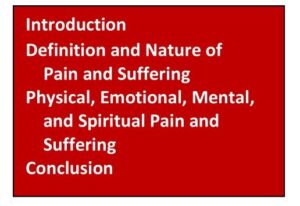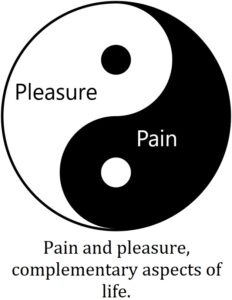Pain and Suffering—The Good News, Part I
INTRODUCTION
The good news—pain and suffering can often (but not always) be avoided, reduced, and eliminated. To learn how to how to avoid, reduce, and eliminate pain and suffering is the goal of this series of Letters for Insight and Innovation. We will describe ways to use pain and suffering for our benefit seeing that they can play an extremely important role for problem solving and personal growth, and as guidance in many situations that we encounter. For pain and suffering we will: offer a definition, examine our beliefs, explore their cause and effects, describe how to reduce, eliminate, and heal them, and identify the blockages to healing.
We have an inherent, a built in, motivation to end pain and suffering. We don’t want to feel them and instinctively move away from them. Yet there are blockages to ending pain and suffering. We will examine our beliefs about pain and suffering because beliefs determine our experience and create the blockages. We will examine self-created pain and suffering, the pain and suffering we have the most control over.
Point of Empowerment: Our beliefs determine the actions and reactions that create our experience of pain and suffering.
Pain and suffering are a common and inevitable experiences in being a human being. We tend to passively accept the pain and suffering in our lives thinking that there is nothing we can do about them. There is always a cause for pain and suffering. Identifying the cause is a crucial part of the process of reducing, eliminating, and avoiding pain and suffering. Through learning, understanding, and changing our approach—our strategies, we can minimize pain and suffering and increase the pleasure that we can find in life.
In this Letter we will discuss some basic concepts that provide the foundation for later explorations.
DEFINITION
First we will explore the nature and definition of pain and suffering because a having a clear definition helps us identify causes and therefore what to do to alleviate pain and suffering. Pain and suffering are different but they can come to us together. Pain is a specific, localized, sensation in our body. It is a feeling. It is a signal from our body that something is wrong, that there is something we need to pay attention to. We are genetically programed to experience the existence of pain but our personal experience and interpretation of the meaning of pain is subjective and unique—entirely up to us as individuals. We say, “I am in pain,” which shows how engulfed we can be by pain. “There is pain present in me,” is a statement that give some sense of separation and distance between pain and ourselves and is therefore a statement that can give us some relief. Pain is generally unwanted, with some exceptions, exceptions where pain is experienced as pleasure. And pleasure can also be experienced as painful.
Point of Empowerment: Pain is a signal from our body that something is wrong, that there is something we need to pay attention to.
Suffering is a complex generalized experience characterized by some or all of—discomfort, angst, anguish, agony, and torment. Grief, sorrow, sadness, helplessness, and unhappiness can also be aspects of a person’s suffering, and pain is always present in suffering because the feelings of suffering are full of pain. A general cause of suffering is feeling pain without any hope that it will end or that there is nothing a person can do to alleviate the pain he/she is in. Chronic, unrelenting pain also turns into suffering. Another basic cause of suffering is intense pain caused intentionally by another person that we are helpless to prevent. Pain inflicted on us unintentionally tends to cause less suffering than pain intentionally inflicted on us. We say, “They did not mean it.” This helps us diminish our suffering.
Depression, anxiety, fear, or dread often accompany both pain and suffering. Pain and suffering come in varying amounts—small, medium, and large with every degree in between being possible. Pain and suffering get worse over time if we do not address and resolve the causes. We can have pain without suffering but as we said there is always pain with suffering.
Point of Empowerment: Most importantly pain and suffering are reactions to something that is happening. This is good news because we always have the freedom to choose our reaction to something, though the range of possible choices may be limited.
There is physical, emotional, mental, and spiritual (PEMS) pain and suffering. The source (cause) can be external, from outside ourself or internal, from within ourself. We can also think of pain and suffering as unavoidable and avoidable. There is nothing we can do to prevent unavoidable pain and suffering. Our task is to find an effective response to what we are experiencing. But we can avoid pain and suffering by developing effective strategies for living. 
Pain can be contrasted with pleasure. We avoid pain and seek pleasure. This duality of life provides a contrast that we are sensitive to. It is absolutely necessary as it provides us with the information we need to make good choices and therefore to develop effective strategies for living. The pleasure pain duality helps us explore our life and environment, and helps us to learn, grow, develop, mature, and evolve.
Point of Empowerment: Pain provides us with crucial information of great value.
Point of Empowerment: We want to create a future for ourselves with less pain and more pleasure by using our human abilities to master the art of living.
The following table is a way of organizing our thoughts about pain and suffering. We will fill in this chart as we go along.
| Unavoidable | Avoidable | |
| Physical Source: Internal | ||
| Source: External | ||
| Emotional Source: Internal | ||
| Source: External | ||
| Mental Source: Internal | ||
| Source: External | ||
| Spiritual Source: Internal | ||
| Source: External |
We said that pain is a feeling so that our experience of physical, emotional, mental, and spiritual pain is a painful feeling. We can then trace this feeling to its cause. We experience many different painful (full of pain) feelings/emotions and give them names like unhappiness, sadness, rage, anxiety, depression, grief, hostility, confusion, dislike, disgust . . . the list is immense. The base layer of these feelings/emotions is pain. We add the next layer of feeling according to the situations and contexts that we exist in as we experience painful feelings and emotions.
Physical pain is the most basic kind of pain we experience. It is the most noticeable form of pain. Emotional, mental, and spiritual pain first appear as a physical painful sensation. We then interpret the meaning of the feeling and determine what we are experiencing, deciding if it is physical, emotional, mental, or spiritual pain and suffering or some combination of these types of pain and suffering.
Emotional pain is experienced in the realm of feelings. Emotional pains are painful feelings and as we said there are an immense number of painful feelings. What is the difference between a feeling and an emotion? We can say that feeling is a felt sensation that we experience in our body. Somewhat arbitrarily, we can define emotion as the combination of feeling and thought. This distinction is extremely useful as it furthers our understanding of ourselves. Thoughts and feelings always come together though we may not be aware of one or the other. When we have a painful feeling we need to look for the thought that accompanies it. This will enable us to investigate the emotion that we are experiencing to determine the cause.
immense number of painful feelings. What is the difference between a feeling and an emotion? We can say that feeling is a felt sensation that we experience in our body. Somewhat arbitrarily, we can define emotion as the combination of feeling and thought. This distinction is extremely useful as it furthers our understanding of ourselves. Thoughts and feelings always come together though we may not be aware of one or the other. When we have a painful feeling we need to look for the thought that accompanies it. This will enable us to investigate the emotion that we are experiencing to determine the cause.
Exaggerated and overly dramatic negative feeling/emotions create overly intense pain and suffering.
There is an appropriateness and reasonableness to our feelings and emotions. Appropriate feelings could be called natural, feelings coming from our human nature and that everyone we would feel in similar circumstances. Natural feelings can be contrasted with “unnatural” feelings, feelings that arise from our interpretation of an event not from the event itself. An event happens, we interpret it according to our belief systems, and feelings result from our interpretation. Inappropriate, unreasonable, and “unnatural” emotions/feelings generate unnecessary and therefore avoidable pain. For example, our boss, who generally likes us, has yelled at us. We become fearful and afraid of being fired. We interpreted our boss’s anger as a situation where we will be punished. Our fear arose from the fear of being punished, which is an interpretation. In addition, there is compounding pain and suffering: the fear of fear, feeling anxious about feeling anxious, and suffering because of suffering. Compounding can increase until the feelings are resolved.
We say, “You hurt my feelings.” This can be an honest expression of pain. But beyond expressing, we often say this when someone has done something we don’t like and we want that person to stop whatever he/she is doing. We are making a request, that can also feel like a demand. “Don’t hurt me” is implied but not stated directly because we may be afraid and therefore unable to express ourself directly. If we say, “You hurt my feelings,” in a tone of voice designed to induce guilt in the other person we are using our pain as a manipulation, exerting a hidden pressure on the other person. If the other person then gives us what we want our behavior seems to work and we feel encouraged to repeat this approach to getting what we want. We may now look for opportunities to claim that our feelings are hurt hiding the underlying demands we make on other people. Genuine hurt feelings is often a quiet sensation. It can occur when we have reached out to another person in some way and have been rejected. The rejection is painful.
Point of Empowerment: When we feel powerless we may use our pain and suffering as a source of power to manipulate other people. If this strategy works we will repeat it holding onto our pain and suffering because it is useful in helping us get what we want.
Mental pain and suffering are generated by mental processes. Our mental process take place in the realm of ideas. In this realm we use our brain and our mind. Our perceptions of our internal and external worlds are included in this category. We can have mental “failures,” a situation where we are trying to accomplish something mentally but fail. We register this failure with some sort of discomfort and/or frustration. Decision making is an example of this. When we want to decide but cannot we experience the discomfort of mental pain and possibly suffering if our frustration is chronic and intense enough.
We innately seek consistency—the state where the aspects of our inner life fit together in peace and harmony. Consistency is when there is no conflict or contradiction among our feelings, thoughts, ideas, beliefs, values, and ideals. And our actions agree with, are “resonant” with, our beliefs, values, and ideals. In reality we always have some degree of conflict and contradiction within us. This is normal and actually healthy as it can stimulate personal growth. However, there is pain in inner conflict, contradiction, and inconsistency. This kind of pain can be called cognitive dissonance. The feelings that accompany cognitive dissonance can be any one or combination of discomfort, disturbance, confusion, fear, and anxiety depending on the intensity of the inner conflict, contradiction, and inconsistency. Confusion is also a mental pain that occurs when we don’t know what to do or don’t understand something. We say, “I feel confused,” expressing the painful feeling that accompanies the mental state of confusion.
Spiritual Pain. Many people doubt the existence of spiritual pain but it could be described as the suffering we experience due to our disconnection from the transcendent. This disconnection is experienced as a kind of loneliness, restlessness, emptiness, meaninglessness, or confusion about life and how to live life. The transcendent can be thought of as God, the Universe, Mystery, the Other, or That which is larger than ourself. We seek an experience of the transcendent whether we know it or not. We may hope that religion will provide us with this experience. Experiencing drug induced alternate realities is another example of seeking the transcendent. We want to know that there is something greater than our little selves. Without this knowing we can see life as meaningless and feel terrified of death. Since experiencing the transcendent is a human need, we suffer when this need is not fulfilled. Some people experience tremendous suffering if the experience of the transcendent is missing in their life.
To end this Letter on a positive note:
Point of Empowerment: Avoiding and preventing pain and suffering is accomplished with effective strategies for living—the constructive and functional approaches that bring us happiness.
CONCLUSION
We explored some foundational ideas about pain and suffering. In the next Letter we will discuss the role of our beliefs play in influencing and actually creating our experiences of pain and suffering. We will begin to consider the causes of pain and suffering and therefore finding keys to alleviating and preventing them.
